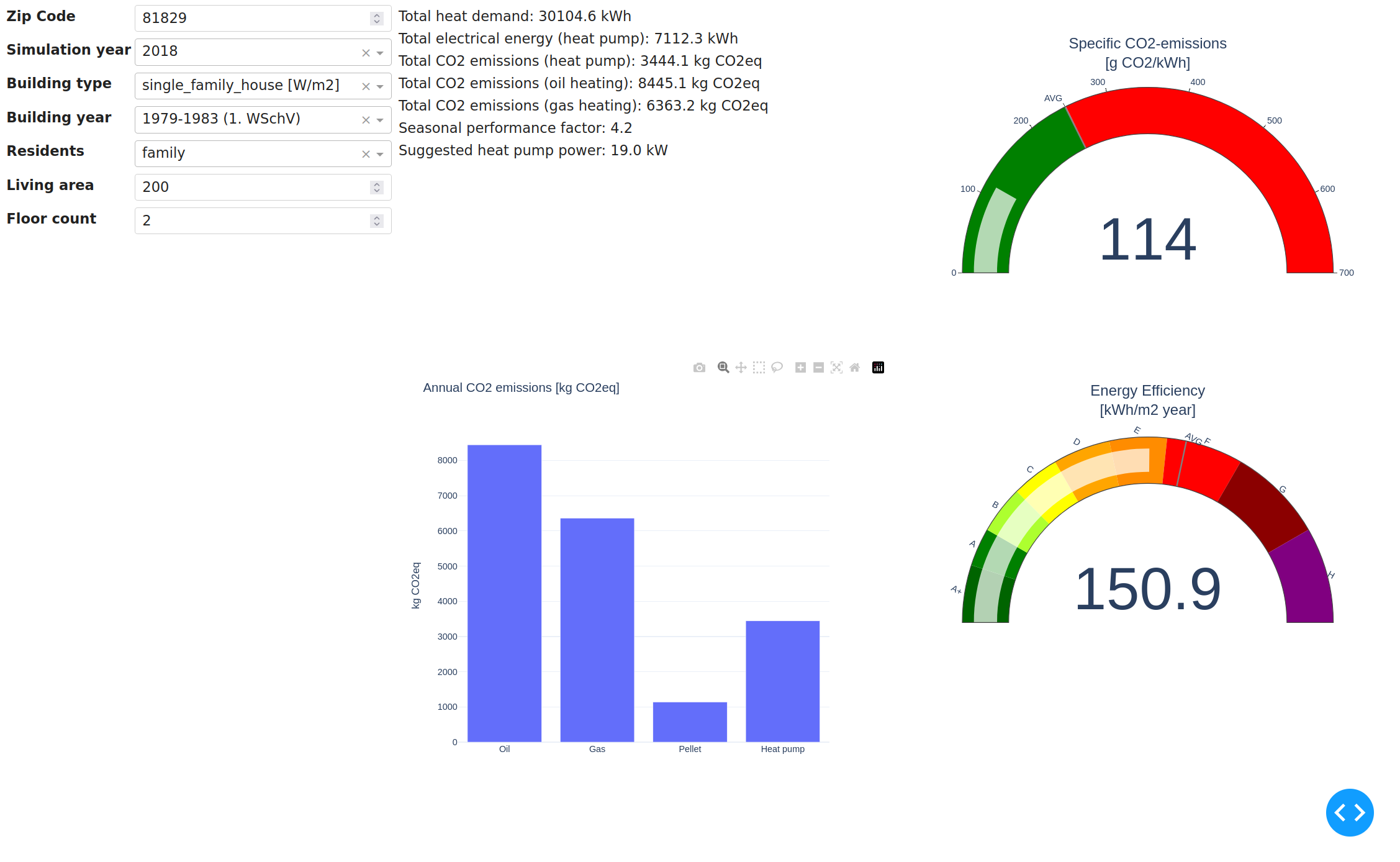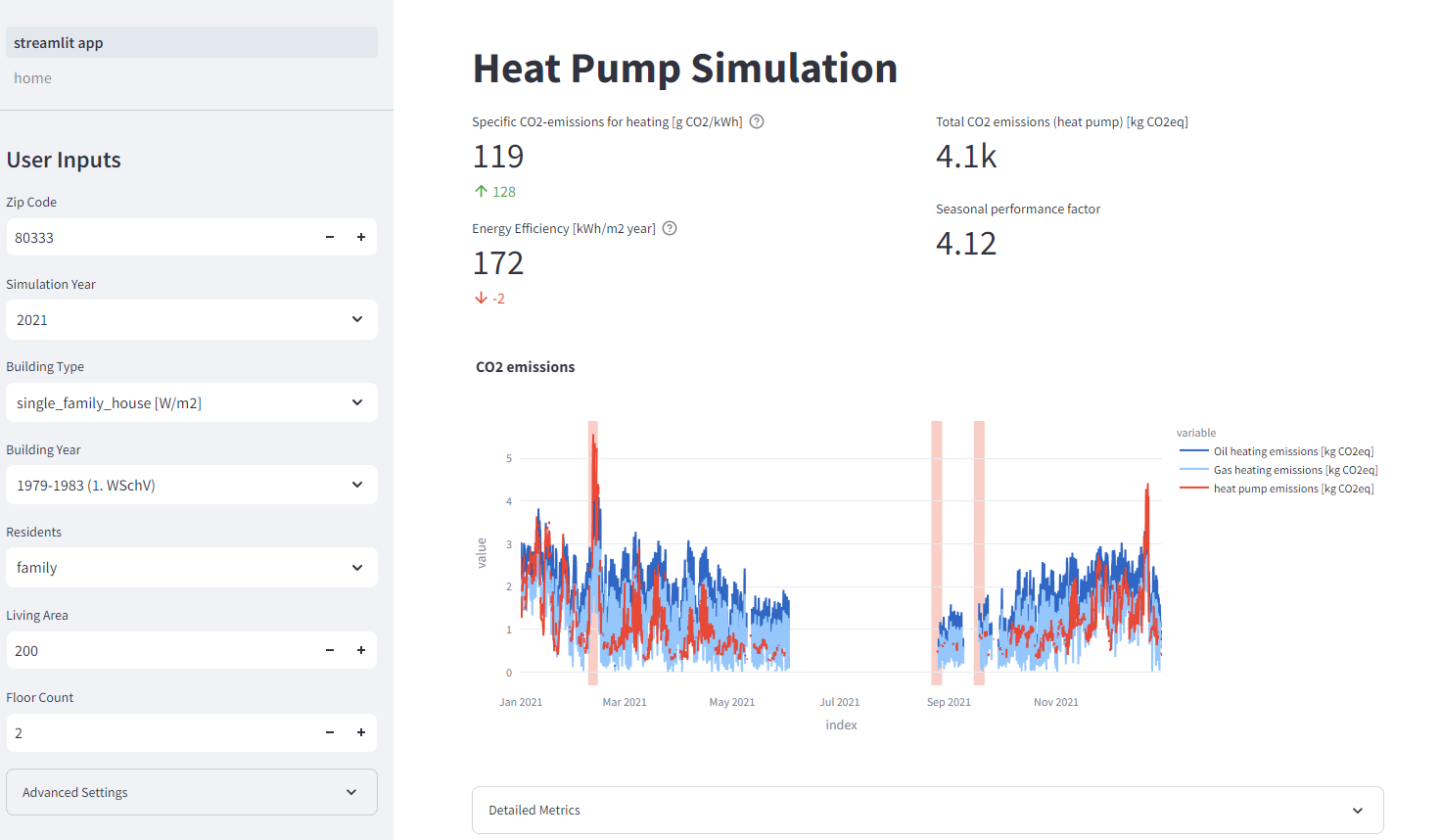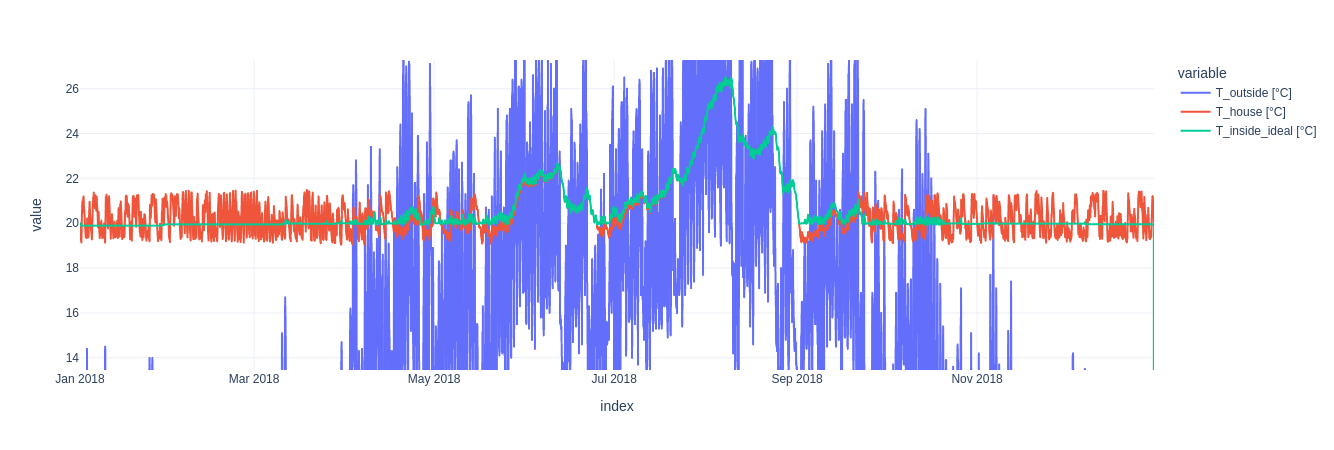With the expansion of renewable electricity sources, heat pumps have the potential to provide a completely
We model the building as an open thermodynamic system in a heat bath (outside environment). The entire building is assigned a single temperature, so like a homogeneous block in a perfectly equilibrated steady state. The building is parametrized by its heat capacity
The transfer due to the temperature gradient to the outside at a given timestep is then:
$ \begin{equation} \dot{Q}=UA\Delta T = \sum{U_{i} A_{i} (T_{outside} - T_{house})} \end{equation} $
This equation gets additional terms for ventilation, heat produced by electrical appliances, habitants, and heating due to solar radiation. $ \begin{equation} \dot{Q}=UA(T_{outside} - T_{house}) + 0.95\cdot P_{internal} + g_{window} P_{solar} + P_{heat : pump} + n_{ventilation:rate} c_{air} V_{air} \rho_{air} \end{equation} $
Finally, the temperature in the house is defined as
If "close window blinds in summer" is in the model assumptions, we redefine P_solar slightly, such that less solar radiation comes through the windows on hot days: $ P_{\text{solar:adjusted}} = \begin{cases} P_{\text{solar}} & \text{if } T_{\text{outside}} > 22^\circ \text{C} \ 0.1 \cdot P_{\text{solar}} & \text{else} \end{cases} $
The simplified model is populated by a series of sensible defaults for all inputs, which are not exposed to the user. For example, we set the
The academic Dashboard version is intended for deeper exploration of the data. We tried to expose as much control over the simulation parameters as possible, including some model assumptions. Particularly the electricity mix input is valuable for testing hypothetical scenarios, e.g. different expansions of renewable energies in as part of the energy mix.
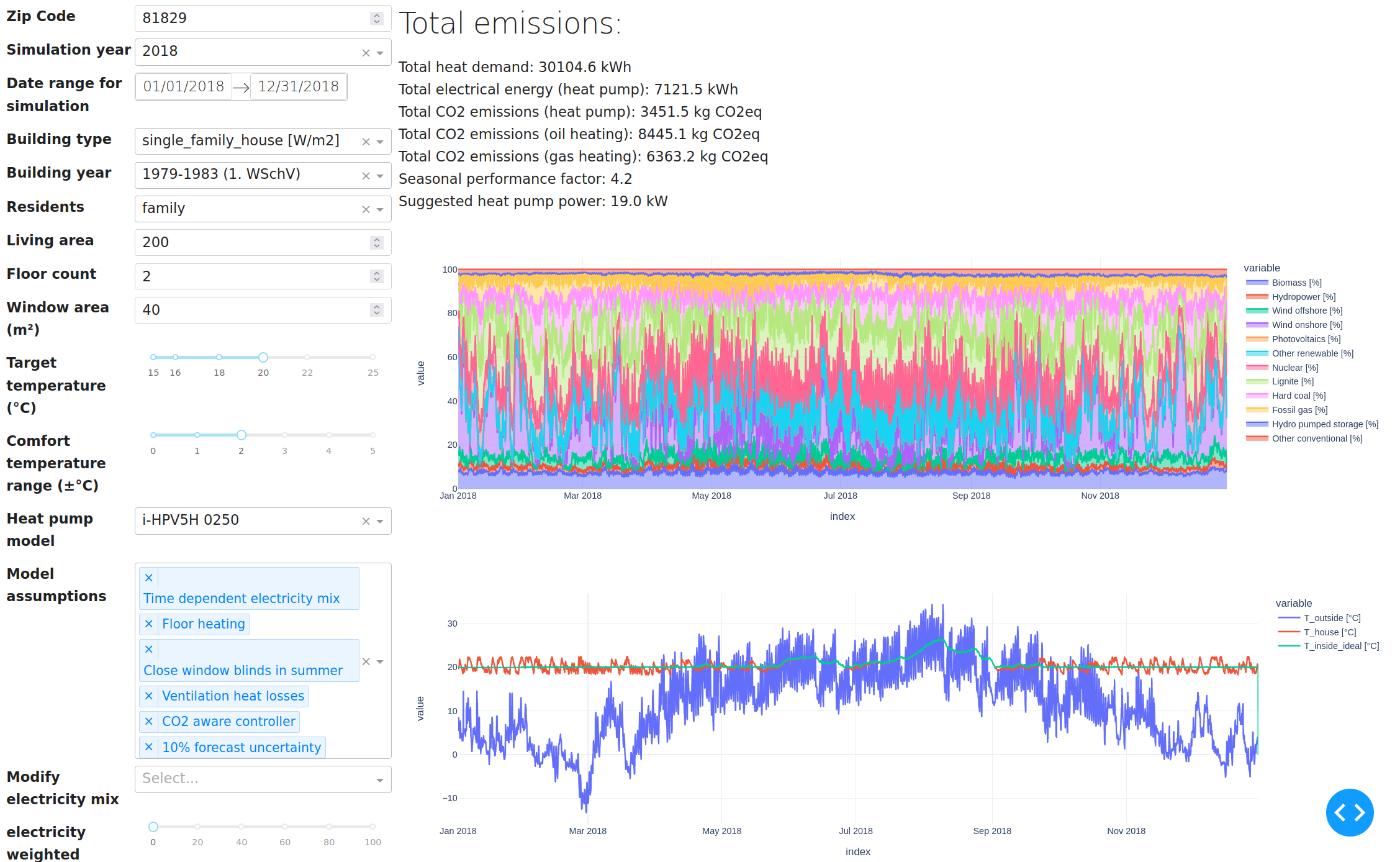 The academic dashboard has customizable plots where the user can select arbitrary timeseries data to display. We tried to make all intermediate calculation steps available. The units are always marked in square brackets after the variable name and are automatically displayed on the y-axis label in the new dashboard version. Selecting the bar display type sums up the values in bins over the individual months, e.g. to analyze the monthly electricity usage. Since we are using
The academic dashboard has customizable plots where the user can select arbitrary timeseries data to display. We tried to make all intermediate calculation steps available. The units are always marked in square brackets after the variable name and are automatically displayed on the y-axis label in the new dashboard version. Selecting the bar display type sums up the values in bins over the individual months, e.g. to analyze the monthly electricity usage. Since we are using 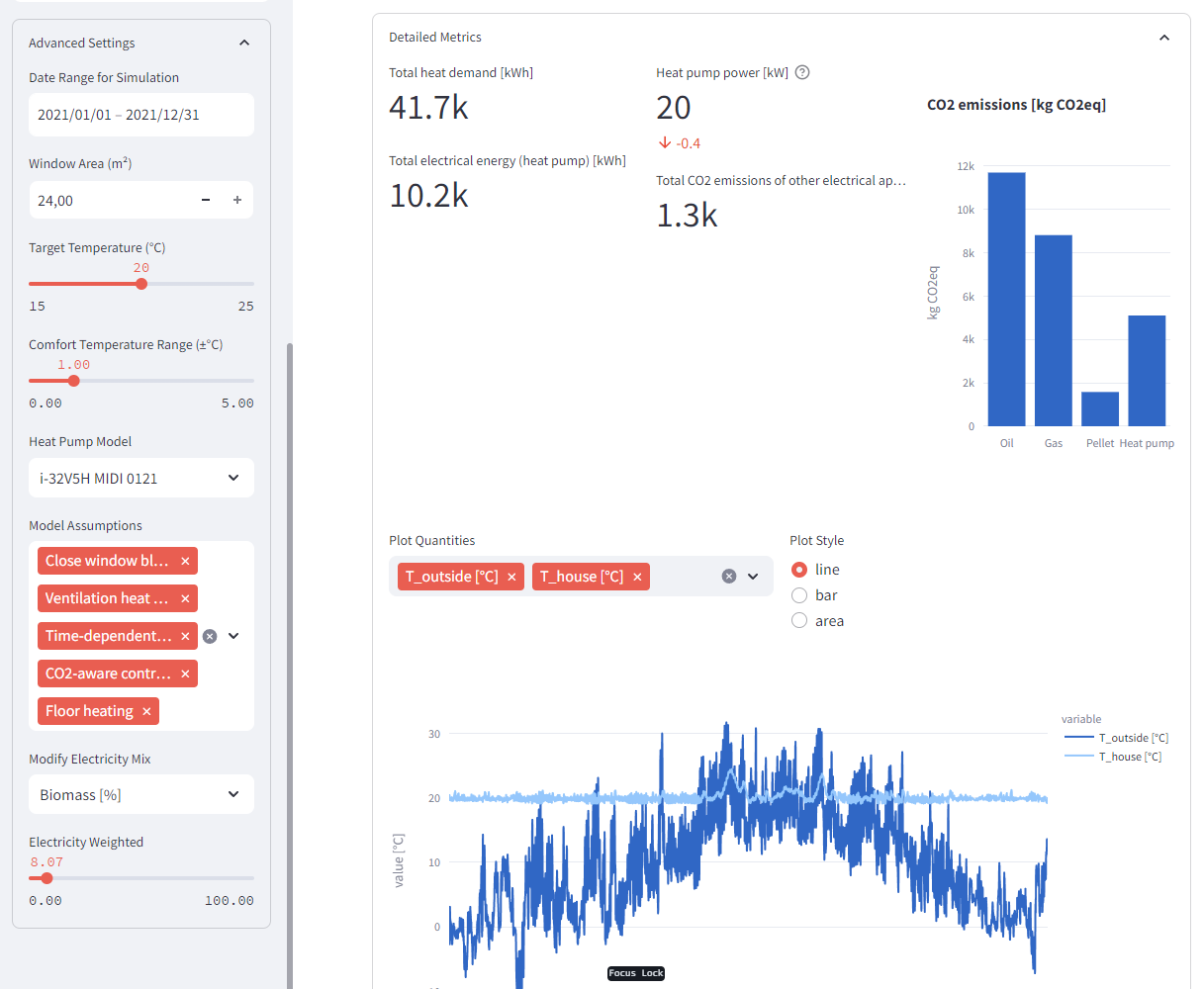
| Column | Unit | Description |
|---|---|---|
| p_solar (south/east/west) | Specific solar radiation strength for a vertical surface facing south/west/east respectively. This already includes corrective factors from literature for average shading, non-perpendicular radiation and self shadowing due to the window frame. | |
| P_solar | Total heating power due to solar irradiation, assuming equal distribution of windows over north, south, east and west. Computed as |
|
| T_{outside} | Outside air temperature used for computing the heat losses and COP of the heat pump | |
| T_{house} | Average temperature of the building. Air temperature and wall temperature are not treated independently. | |
| Wind offshore, Biomass, Nuclear... | Percentage of the specific energy source in the electricity mix. | |
| Intensity | The |
|
| Intensity per heat | The |
|
| P_el appliances | Electricity consumption of household appliances, e.g. oven, computer... This is added to the house as heat using a factor of |
|
| P_el heat pump | Electricity consumption of the heat pump. This is not added as heat to the building. | |
| Q_dot_demand | Theoretical heat demand to fulfil the temperature requirements. | |
| Q_dot_supplied | Actual amount of heat supplied to the building by the heat pump. May be less than Q_dot_demand if the heat pump is chosen too small | |
| Q_dot_transferred | Heat transfer to the outside of the building through walls, windows, ceiling and floor. | |
| Q_dot_ventilation | Heat transfer due to periodic ventilation of the building. We assume that |
The controller tries to minimize g CO2eq/kWh of the current electricity mix, but we soon realized, that the temperature dependent COP of the heat pump also has to be taken into consideration. We actually want to heat when g CO2eq/kWh heating is minimal. This metric takes into account both the temperature dependent COP and the
Initially we used time window of
We therefore introduced an extension to the base control strategy, that allows to choose a minimum and maximum temperature, from which a time window for optimization is computed. The window is simply determined by the time it takes for the building to get colder or hotter than the minimum temperature naturally. Thereby we ensure, that even in the most extreme cases (no heating for the entire period) the temperature deviation is limited. The controller is now able to produce a much more stable temperature profile, while still optimizing for
Of course a larger temperature variation allows for lower 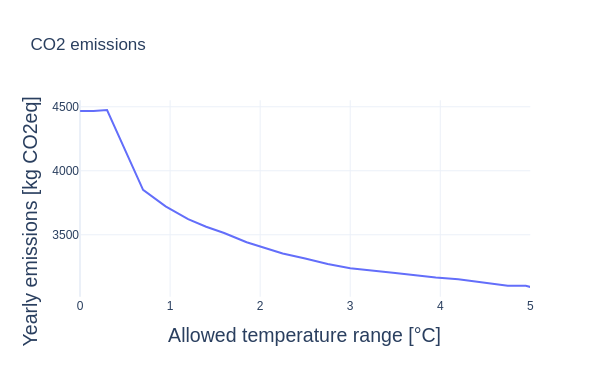 All the figures in this section are computed for a
All the figures in this section are computed for a
To validate our model, we compared the results to various rule of thumb formulas from DIN-12831.
There are tabular reference values for the maximum outside temperature at which heating is required (Heizgrenztemperatur) defined in the standard. Since real buildings have a significant heat capacity, they react delayed to temperature changes. We therefore read off the 7 day moving average of
We also compared our model to standard heating load profiles and got results within a reasonable deviation range of
Finally we compared our results to a real single family house from 1980, for which we knew the heat demand in previous years. We also had estimated heat demands, heat capacities and specific transfer coefficients of the building as determined by a heating consultant. The heat capacity computed by the model is
In general we noticed that our model predicted lower heat demand for modern KfW70, KfW40 and GEG20 buildings, compared to the DIN standard. We also observed excessive heating in the summer, due to solar radiation and other internal gains. This is apparently a known issue with the standard, as it completely ignores internal heat sources, even though they are a relevant factor in well isolated buildings.
Take into account more factors, e.g. To further enhance our analysis, it is crucial to consider additional factors, such as the influence of domestic hot water consumption, which is likely to have a significant role in the overall system dynamics.
In addition, exploring the economic implications alongside environmental impacts presents an intriguing avenue. This can be achieved with minimal algorithmic adjustments, primarily involving the substitution of data sources. Although we briefly experimented with modeling a hot water storage tank within the household, it only resulted in minimal impact on the outcome. In reality, hot water storage tanks are essential for any heat pump installation, as they service the short bursts of domestic hot water demands, for which the heat pump would react too slowly.
Time dependent electricity mix played a smaller role than expected. Especially when using the
Electric and hot water load profiles for different households were generated by Fraunhofer ISE. An additional dataset for hot drinking water was taken from the district energy planning tool nPro
We follow the methodology described by electricitymaps.com with most data aggregated from this 2014 IPCC report. Hydro pumped storage was adjusted for Germany, as the global estomate is too optimistic.
According to the Department of Economics at the University of Verona the effective carbon footprint is 31% above the grid average due to round trip losses. electricitymaps.com does not account for these additional losses. Additionally the
- http://www.bosy-online.de/heizlastberechnung_nach_din_en_12831.htm
- https://www.waermepumpe.de/normen-technik/heizlastrechner/
- https://www.npro.energy/main/de/load-profiles/heat-load-and-demand
https://www.effizienzhaus-online.de/lexikon/heizgrenztemperatur/
| Values for the 1980 house we used for comparisions | |
|---|---|
| Living area: | 200 |
| Window area: | 51.9 |
| Heat capacity: | 328000 |
| Average specific heat conductance: | 0.7293 |
| Air volume: | 1251 |
| Historic heating oil consumption: | 3000 |
| Historic heating power consumption: | 30000 |
For accurate heat pump models we are using hplib
Citation: Tjarko Tjaden, Hauke Hoops, Kai Rösken. (2021). RE-Lab-Projects/hplib: heat pump library (v2.0). Zenodo. https://doi.org/10.5281/zenodo.5521597

